Hyperpolarized C13 Imaging
Hyperpolarized C13 Imaging
Oral
Oral
Molecular Imaging
Wednesday, 15 May 2019
| Room 510A-D | 08:15 - 10:15 | Moderators: Myriam Chaumeil, Esben Hansen |
08:15 |
0716. 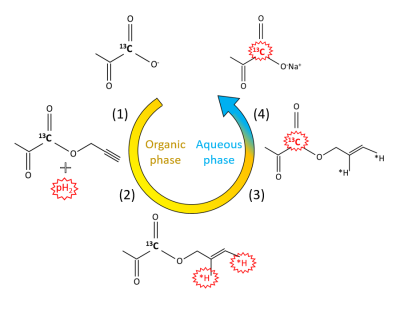 |
First in cellulo and in vivo metabolic studies using ParaHydrogen Hyperpolarized [1-13C]pyruvate
Eleonora Cavallari, Carla Carrera, Silvio Aime, Francesca Reineri
Hyperpolarized (HP) [1-13C]pyruvate [1] has been widely exploited for the metabolic processes. The development of this agent has enabled the in vitro and in vivo real-time detection of pyruvate-lactate metabolic conversion. The possibility of obtaining HP pyruvate using the cost effective and fast PHIP (ParaHydrogen Induced Polarization) method, instead of the dissolution Dynamic Nuclear Polarization (d-DNP), would allow a widespread application of this powerful diagnostic tool, that so far has been hampered by cost, technical complexity and intrinsically low polarization time. Here we report an in vitro and in vivo study carried out on different cancer cell lines and in vivo using PHIP-SAH HP-[1-13C]pyruvate.
|
| 08:27 |
0717.  |
Probing the metabolic response to acute renal injury in mice using multiple hyperpolarized 13C substrates.
Camille Ansermet, Gabriel Centeno, Mario Lepore, Stefanita Mitrea, Analina da Silva, Shinsuke Sando, Dmitri Firsov, Hikari Yoshihara
Arginase-2 is upregulated following renal injury. This study used hyperpolarized pyruvate, arginine, citrulline and γ-glutamylglycine to probe changes in renal metabolism following ischemia-reperfusion in mice deficient in renal arginase-2. The kidney is a major site of arginine synthesis, and conversion of hyperpolarized citrulline to arginine can be detected, as can a signal consistent with argininosuccinate. While metabolic differences in mice lacking arginase-2 compared to controls are not readily apparent by this method, ischemia has a clear effect on several metabolite signals. Of the pyruvate metabolites, conversion to aspartate is significantly diminished, as is arginine and argininosuccinate production from citrulline.
|
| 08:39 |
0718. 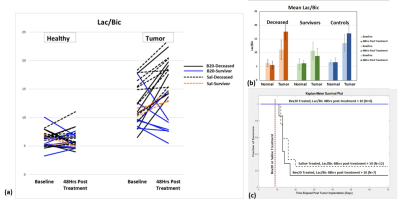 |
Hyperpolarized [1-13C]Pyruvate MRSI at 48 hrs post anti-VEGF Treatment Predicts Response in C6 Glioma Implanted Rats
Keshav Datta, Mette Lauritzen, Milton Merchant, Taichang Yang, Shie-Chau Liu, Ronald Watkins, Ralph Hurd, Lawrence Recht, Daniel Spielman
Using a bolus injection of hyperpolarized [1-13C]Pyruvate, we show that measurement of the resulting 13C-Lactate to 13C-Bicarbonate ratio 48-hours post-treatment with anti-angiogenic drug Bevacizumab (Bev20) predicts survival in a C6-Glioma rat model. A positive correlation of Lac/Bic with tumor growth rate further supports our hypothesis that the effect of the drug in survivors is to reverse the tumor Warburg metabolic phenotype necessary to support rapid proliferation.
|
08:51 |
0719.  |
Hyperpolarized [1-13C] Alanine Ethyl Ester for Assessment of Hepatic Alanine Metabolism
Jun Chen, Edward Hackett, Richard Martin, Zoltan Kovacs, Jae Mo Park
[1-13C] alanine ethyl ester was studied as hyperpolarized substrate to measure the alanine metabolism in rat liver. The results show that [1-13C] alanine ethyl ester enters the cell converts to [1-13C] lactate more efficiently. Therefore, [1-13C] alanine ethyl ester is a potential compound to assess hepatic alanine metabolism with improved sensitivity.
|
09:03 |
0720.  |
Mildronate Modulates In-Vivo Metabolism and Improves Ex-Vivo Functional Recovery Post-ischemia in the Diabetic Heart
Dragana Savic, David Hauton, Lorenz Holzner, Vicky Ball, Lisa Heather, Damian Tyler
Carnitine acts as a buffer of acetyl-CoA units in the mitochondria, as well as facilitating
|
09:15 |
0721. 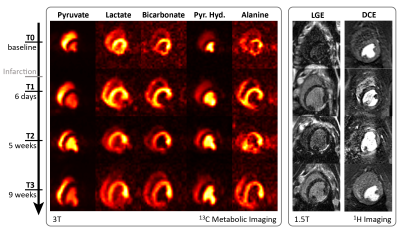 |
Longitudinal Hyperpolarized 13C Imaging of Metabolic Changes Following Myocardial Infarction in Pigs
Maximilian Fuetterer, Julia Traechtler, Julia Busch, Andreas Dounas, Sophie Peereboom, Mareike Gastl, Mareike Sauer, Miriam Lipiski, Thea Fleischmann, Nikola Cesarovic, Christian Stoeck, Sebastian Kozerke
The heart’s dynamic, bimodal response to myocardial infarction warrants longitudinal study designs to better understand the interplay between perfusion deficits, metabolic processes and function. To this end, a longitudinal study over 12 weeks was set up to probe myocardial metabolism post-infarction in an infarct pig model using hyperpolarized [13C]-pyruvate. Image acquisition was optimized for improved spatial and temporal image fidelity based on spectrally-selective excitation and EPI readouts. Initial results demonstrate good agreement with supplementary gadolinium enhanced imaging and indicate a temporal metabolic shift towards increased lactate-to-bicarbonate ratios in the lesion territory caused by cardiac infarction.
|
09:27 |
0722. 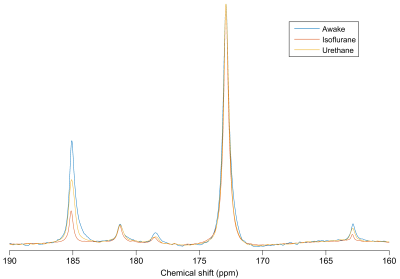 |
Metabolism of hyperpolarized [1-13C]pyruvate in awake, isoflurane and urethane anesthetized rat brain
Viivi Hyppönen, Petteri Stenroos, Riikka Nivajärvi, Jan-Henrik Ardenkjær-Larsen, Olli Gröhn, Jaakko Paasonen, Mikko Kettunen
Pre-clinical MRI/MRS routinely uses anesthesia, which alters hemodynamics and metabolism. Here, we used hyperpolarised [1-13C]pyruvate to compare brain metabolism under isoflurane or urethane anesthesia and in awake rats. Spectroscopic [1-13C]pyruvate time courses were measured in sequence in awake, isoflurane and urethane anesthetized rats. Bicarbonate- and lactate-to-total carbon ratios decreased in order from awake animals to urethane to isoflurane anesthetized animals. No change was observed in bicarbonate-to-lactate ratio between the groups, however. The study shows dDNP experiments can be performed in awake rats thus avoiding issues related to anesthesia. However, the ratios between intracellular metabolites did not alter in awake rats.
|
09:39 |
0723. 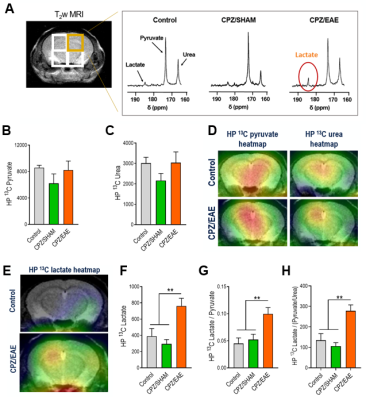 |
Metabolic imaging of brain inflammation using hyperpolarized 13C MRSI of pyruvate and urea in a mouse model of multiple sclerosis
Caroline Guglielmetti, Christian Cordano, Chloe Najac, Ari Green, Myriam Chaumeil
We used conventional MRI and hyperpolarized 13C magnetic resonance spectroscopy (HP 13C MRSI) quantitative imaging of pyruvate and urea to assess lesion pathology and the metabolic signature in a model of multiple sclerosis (MS). T2 sequences detected white matter lesions and gadolinium-enhanced MRI showed blood-brain-barrier breakdown. HP 13C MRSI revealed increased lactate production and lactate-to-pyruvate ratios while urea levels remained unchanged. This is consistent with macrophage/monocyte infiltration into the CNS found in the model. Altogether, these findings demonstrate that HP 13C MRSI has potential to monitor macrophage infiltration and innate immune activation in inflammatory diseases of the central nervous system.
|
| 09:51 |
0724. 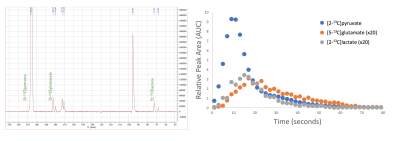 |
First Hyperpolarized [2-13C]Pyruvate MR Studies of Human Brain Metabolism
Brian Chung, Hsin-Yu Chen, Jeremy Gordon, Daniele Mammoli, Renuka Sriram, Adam Autry, Lydia Le Page, Myriam Chaumeil, Peter Shin, James Slater, Chou Tan, Chris Suszczynski, Susan Chang, Robert Bok, Sabrina Ronen, Peder Larson, John Kurhanewicz, Daniel Vigneron
We investigated hyperpolarized (HP) [2-13C]pyruvate conversion to [2-13C]lactate and [5-13C]glutamate for the first time in the healthy human brain, with a focus on the development of hyperpolarization and preparation techniques for sterile [2-13C]pyruvate with FDA-IND & IRB approval. HP [2-13C]pyruvate, [2-13C]lactate, [5-13C]glutamate and other metabolites were successfully observed and quantitatively measured for the first time in four volunteers, and initial EPI studies confirmed a feasibility of imaging [2-13C]pyruvate to [5-13C]glutamate conversion, demonstrating a significant first step for HP metabolic imaging to diagnose and detect early stage neurological disorders.
|
10:03 |
0725. 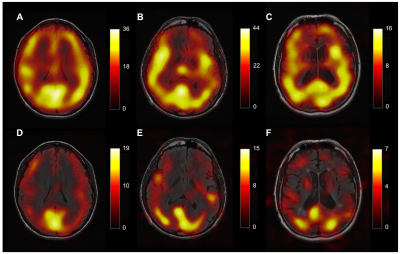 |
Hyperpolarized 13C Metabolic Imaging of a Renal Cell Carcinoma Patient with Brain Metastasis
Casey Lee, Hany Soliman, Benjamin Geraghty, Albert Chen, Nadia Bragagnolo, William Perks, Charles Cunningham
The application of hyperpolarized 13C MRI to non-invasively acquire metabolic images of [1-13C]lactate and 13C-bicarbonate from the injected [1-13C]pyruvate in the brain of metastatic renal cell carcinoma patient, as well as that of 7 healthy volunteers are investigated. Elevated [1-13C]lactate and [1-13C]pyruvate signals were observed from the metastasis, as well as high lactate-to-bicarbonate ratio. The clinical history of the patient suggests that the elevated signals observed in the metastasis may be reflecting the progressive state of the patient’s disease.
|
 Back to Program-at-a-Glance |
Back to Program-at-a-Glance |  Back to Top
Back to Top